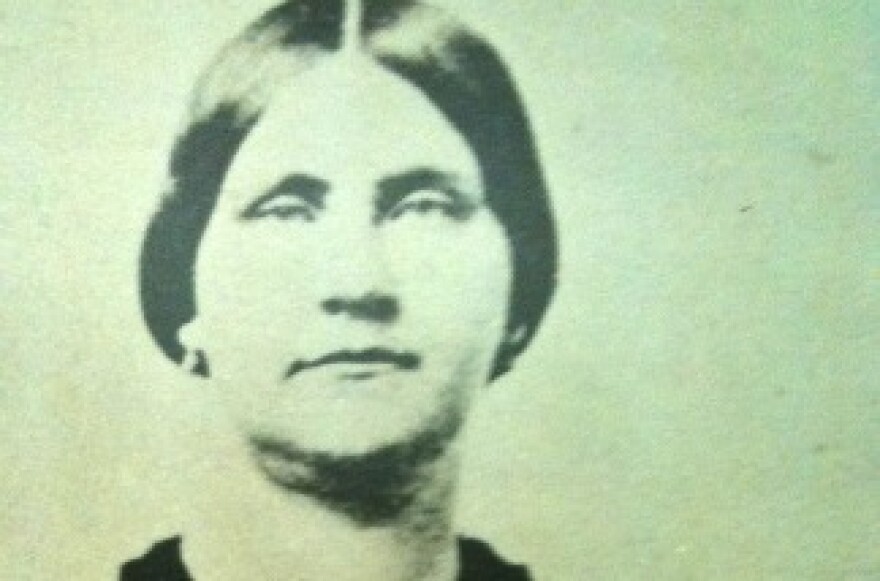With our free press under threat and federal funding for public media gone, your support matters more than ever. Help keep the LAist newsroom strong, become a monthly member or increase your support today.
'The Conspirator' Mary Surratt still haunts Washington

“The Conspirator," Robert Redford’s new film about the Lincoln assassination, follows the story of one of the supposed conspirators: Mary Surratt.
In the film, a judge tells Surratt, "You are charged with having received, entertained, harbored, aided and assisted John Wilkes Booth, John Surratt, and their confederates in traitorous and murderous conspiracy to kill Abraham Lincoln, Vice President Andrew Johnson, and Secretary of State William Seward. How do you plead?"
Surratt says simply, "I am innocent."
Hers is a story that still haunts Washington.
***
Fort Lesley McNair is named for an Army general killed in Normandy during World War Two. The original base dates back more than two centuries; it’s the third oldest military installation in the US.
It’s also where boarding house owner Surratt was tried, convicted and executed for her part in Lincoln’s assassination. Kim Holien points out the spot where the execution took place, "between this sign and the tree to your right near the building, and then the temporary internment took place between this sign and the tree to your left."
Holien is the US Army Civilian Historian for Ft. McNair. He agrees that Surratt got a bum rap from Secretary of War Edwin Stanton. Holien says the government’s witnesses against her included convicted felons and Union Army deserters facing court martial.
"I don’t feel she knew about the assassination so much as she was protecting her son," says Holien. "And Edwin Stanton wanted to get her son in the worst possible way."
Julia Cowdery gives tours at the Surratt House Museum, Surratt’s country home about 10 miles outside of Washington. Cowdery says Surratt’s son John and his best friend, actor John Wilkes Booth, planned to kidnap the president.
"Ultimately," she says, "the kidnapping plot (was) they wanted to capture Abraham Lincoln and take him into Richmond, Va., to hopefully exchange him for Confederate soldiers who were imprisoned failed."
Holien says the conspiracy took a dark turn after Booth heard Lincoln give a speech about giving equal rights to African Americans.
"And Booth turned to one of his companions and said, 'That’s it! I’m going to do him in! That’s the last speech he’s going to make!'"
Surratt ran a boarding house in Washington close to Ford’s Theater. Booth and other conspirators were often there. Rich Amada, who wrote the play “The Judicial Murder of Mrs. Surratt," says despite the title, he keeps an open mind about Surratt’s guilt.
"I have to assume — you can see the house that we’re standing in here is not a huge house — I would have to assume that if these people are coming and going she had to know something was up," says Amada. "I believe Mrs. Surratt knew more than she said she did. Whether or not she was actually in on the conspiracies, I don’t know."
Amada, who’s also a lawyer, says today Surratt could have appealed by claiming her case shouldn’t have been heard by a military tribunal.
"As I look at the evidence, I think to myself a reasonable jury could have found her innocent," he says. "But a reasonable jury just as easily, wearing the same evidence, could have said guilty. So on that grounds, I don’t think you could have the decision overturned."
Laurie Verge is director of the Surratt House Museum in Clinton, Md. She says there's evidence to tie Surratt to the kidnap scheme.
"Maybe in our court system today, we would call it circumstantial evidence. But given the turmoil of the Civil War time period, I can see where that evidence was taken seriously," she says.
Verge sees no rush to judgment. She calls Secretary of War Edwin Stanton one of the government’s “pragmatists.”
"They had to do what had to be done in order in their minds to save the Union," says Verge.
But two years later, the US Supreme Court disagreed. Holien says the high court ruled that Surratt’s trial and execution were illegal.
"Which is maybe why many people claim that her ghost still resides here in the building, because she is so angry over the injustice of her trial and execution," says Holien.
Staff and soldiers say the specter of Surratt still haunts Ft. McNair — as the Civil War still haunts the United States.







